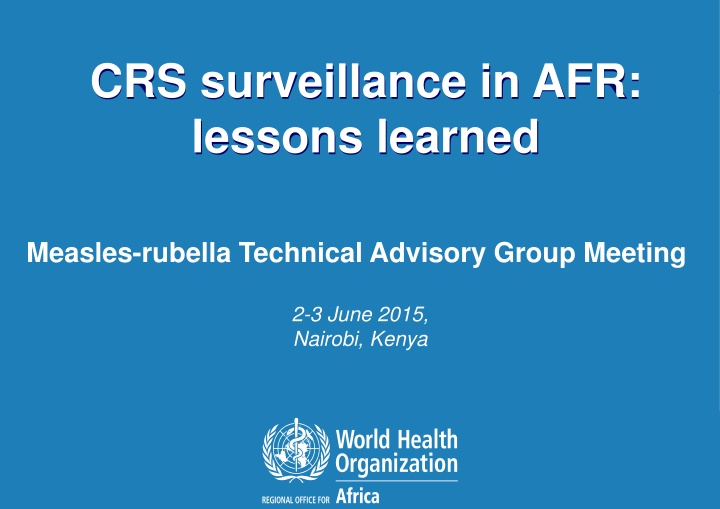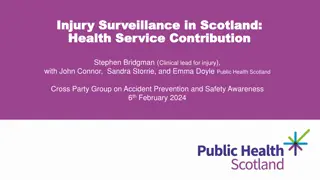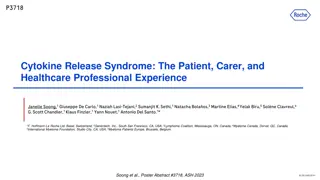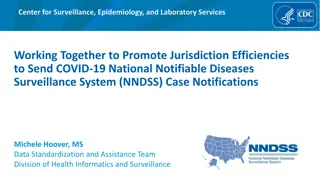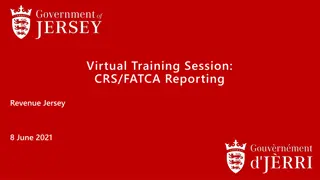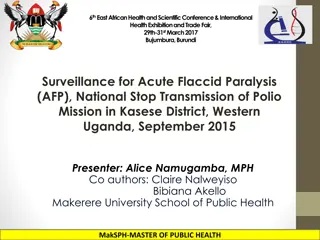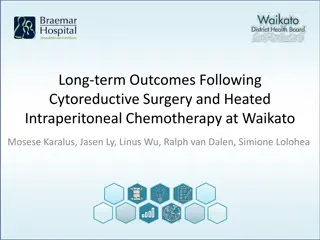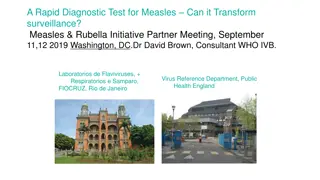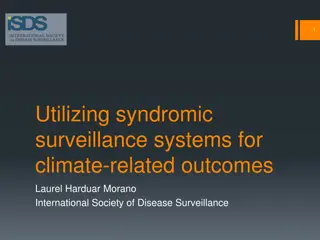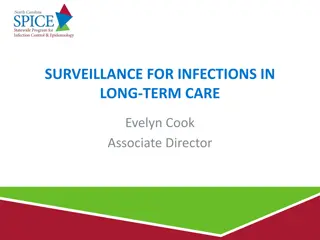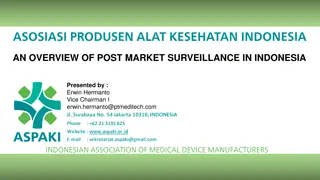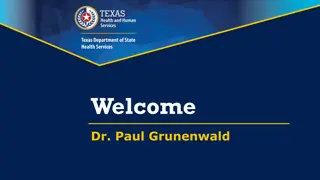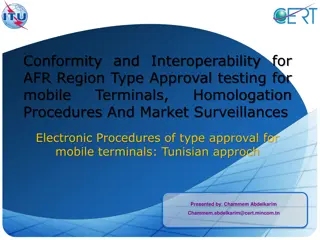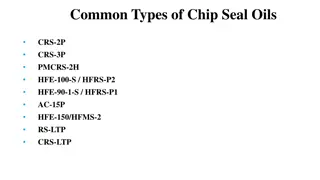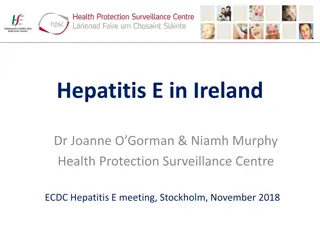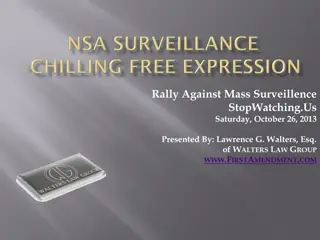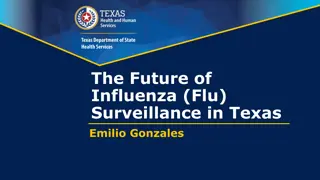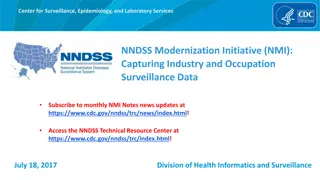CRS surveillance in AFR: lessons learned
Measles-Rubella Technical Advisory Group meeting in Nairobi, Kenya discussed WHO CRS case definitions, retrospective medical record reviews, sentinel surveillance sites, and lessons learned for better CRS surveillance. The meeting highlighted the importance of clinical and laboratory-confirmed CRS cases, as well as identifying infants at risk through retrospective burden reviews. The aim is to improve early detection and management of CRS cases in infants under 1 year.
Download Presentation

Please find below an Image/Link to download the presentation.
The content on the website is provided AS IS for your information and personal use only. It may not be sold, licensed, or shared on other websites without obtaining consent from the author.If you encounter any issues during the download, it is possible that the publisher has removed the file from their server.
You are allowed to download the files provided on this website for personal or commercial use, subject to the condition that they are used lawfully. All files are the property of their respective owners.
The content on the website is provided AS IS for your information and personal use only. It may not be sold, licensed, or shared on other websites without obtaining consent from the author.
E N D
Presentation Transcript
CRS surveillance in AFR: lessons learned Measles-rubella Technical Advisory Group Meeting 2-3 June 2015, Nairobi, Kenya 1|
Outline WHO CRS case definitions Current CRS retrospective medical record reviews and CRS sentinel surveillance sites Summary results CRS reviews and surveillance Lessons learned Way forward 2|
WHO CRS case definitions Clinically-confirmed CRS: A child < 1 year with two manifestations in group (a) or one from (a) and one from (b) Group A: cataract(s), congenital glaucoma, congenital heart disease, loss of hearing, pigmentary retinopathy Group B: purpura, splenomegaly, microcephaly, mental retardation, meningoencephalitis, radiolucent bone disease, jaundice within 24 hours of birth Source: African Regional Guidelines for Measles and Rubella Surveillance. Revised April 2015 3|
WHO CRS case definitions (2) Laboratory-confirmed CRS: A laboratory-confirmed CRS case in an infant with a positive blood test for rubella IgM who has clinically-confirmed CRS Congenital rubella infection (CRI): An infant with a positive blood test for rubella IgM who does not have clinically-confirmed CRS Source: African Regional Guidelines for Measles and Rubella Surveillance. Revised April 2015 4|
CRS sentinel surveillance in May 2015. AFR CRS sentinel surveillance currently established CRS sentinel surveillance planned * * ** *7 countries with MR in routine EPI BFA did MR SIA- intro in routine 2015 * * * * Not on map: Retrospective burden reviews in Swaziland, Rwanda, Uganda Retrospective CRS burden reviews conducted & CRS sentinel surveillance planned 5|
Retrospective CRS burden reviews Identify clinical sites where infants with signs and symptoms consistent with CRS are likely to present Children s hospitals Centers for hearing defects and blindness Centers for disabilities Specialty clinics: e.g. Cardiology, Ophthalmology, Audiology, Neonatology, developmental clinics Consult general physicians, pediatricians, neonatologists, cardiologists, and professionals involved in TORCH* screening programmes Review clinical records covering a period of at least two years, if possible following documented onset of a rubella outbreak To identify clinical entries meeting standard WHO clinical case definitions for CRS To identify a history of maternal rash illness that was provided during pregnancy and lab confirmation if available for suspected CRS case *Toxoplasmosis, Other (syphilis, varicella- zoster, parvovirus B19), Rubella, Cytomegalovirus (CMV), and Herpes infections 6|
Retrospective CRS burden reviews - results Rwanda, 3 sites 2010-12: 43 cataracts, 8 congenital glaucoma Uganda, 4 sites 2011-12: 22 clinically confirmed CRS cases Swaziland, 5 sites 2008-12: 14 cataracts 7|
Results from CRS sentinel surveillance sites case characteristics and completeness of database Country Total cases in data- base Median age in months, range Sex IgM result available Group A manifestatio ns complete n Group B manifestations complete n (% 1 year +) n n Senegal 11 0, 0-15 (10%) 5, 0-10 (0%) M 4 (36%) F 7 (64%) M 25 (46%) F 30 (54%) 11 (100%) -- -- Tanzania 55 53 (98%) 55 (100%) 43 (78%) Togo 42 3.5, 0-20 (14%) M 17 (40%) F 25 (60%) 42 (100%) 42 (100%) 39 (93%) Uganda 6 8, 1-21 (33%) M 3 (50%) F 3 (50%) 6 (100%) 6 (100%) 6 (100%) Zambia 30 9, 0-80 (40%) M 7 (23%) F 23 (77%) 10 (33%), 7 pending 30 (100%) 30 (100%) Zimbabwe 109 0, 0-23 (4%) M 65 (60%) F 43 (40%) 107 (98%) 106 (97%) 107 (98%) Total 242 2, 0-80 (10%) M 117 (49%) F 124 (51%) 225 (93%) 239 (99%) 225 (93%) 8|
Results from CRS sentinel surveillance sites CRS case classification Country Number of children < 1 year in database definition n Total meeting case Clinically confirmed CRS Laboratory -confirmed CRS Congenital rubella infection n n n Senegal 9 0 0 0 0 Tanzania 55 38 (69%) 29 8 1 Togo Uganda Zambia 36 4 18 5 (14%) 4 (100%) 15 (83%) 2 3 13 0 1 2 3 0 0 Zimbabwe 105 Total 43 (41%) 105 (48%) 24 71 11 22 8 12 218 9|
Results from CRS sentinel surveillance sites Age in case categories Age in months Clinically confirmed CRS Laboratory- confirmed CRS Congenital rubella infection n n n 0-2 25 (35%) 10 (45%) 10 (83%) 3-5 20 (28%) 5 (23%) 2 (17%) 6-8 15 (21%) 6 (27%) 0 9-11 11 (15%) 1 (5%) 0 Total 71 22 12 10|
Results from CRS sentinel surveillance sites Group A symptoms in case categories Country Clinically confirmed CRS CRS Laboratory- confirmed Congenital rubella infection Total n n n Cataract(s) Glaucoma 42 (60%) 12 (17%) 18 (82%) 1 (5%) 1 (11%) 0 61 (58%) 13 (12%) Congenital heart disease 50 (70%) 19 (86%) 4 (33%) 73 (70%) Hearing loss Pigmentary retinopathy Total 4 (6%) 13 (18%) 3 (14%) 7 (32%) 0 0 7 (7%) 20 (19%) 11| 71 22 12 105
Lessons learned - strengths 6 surveillance sites collecting data, longest since 2011 (Zimbabwe) 3 more starting (Rwanda) or planned for 2015 (Botswana, Swaziland) Overall high level of data completeness Sites have documented CRS cases as baseline for monitoring after MR introduction Updated AFR measles-surveillance guidelines April 2015 12|
Lessons learned - challenges No regular reporting from sites databases need to be shared, analysed, feed back provided (including WHO) Analysis showed o Cases of age 1 year and above included (up to 40%) o No uniform variable names and variable categories o Variation in proportions of suspected cases that meet case definitions (14- 69%) Variation may indicate natural differences or differences in applying guidelines and/or limitations in diagnostic capacities 13|
Way forward Sub-regional CRS training planned June 17-19, 2015 in Harare (11 ESA countries) to o Update on guidelines, provide current results and discuss lessons learned o Strengthen CRS surveillance network o Work on harmonization of standard operating procedures and reporting o Plan and discuss publications of results from network collaboration Regular network workshops needed for exchange of experiences and results, discussion of modifications needed and reporting/publications, including IST West/Central 14|
Back-up Slides 15|
Current CRS sentinel surveillance sites in AFR Country Site(s) Started CRS surveillance MR intro Senegal Paediatrics Hospital Albert Royer Dakar 2012 2013 Data for 7/14-2/15, no manifestations info Tanzania Dar es Salaam (2), Dodoma (1), Kigoma (1), Kilimandjaro (1), Mbeya (3), Tanga (1), Zanzibar (1) 6/2014 2014 Togo 2 University Clinics in Lome, Be Hospital 2012 ? Uganda Mulago Hospital 10/2014 2018 Zambia Central Hospital, Kitwe; General Hospital, Livingstone; University Hospital, Lusaka; Arthur Davidson Children's Hospital, Ndola 2014 2016 Zimbabwe Harare Hospital 11/2011 2015 16|
